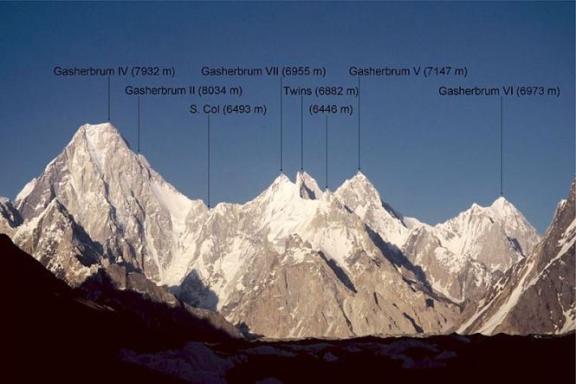Gasherbrum massif. Six towering peaks, two of them over 8,000 meters: G II (8,035 m) and G I (8,068 m). In 1934, the international expedition led by Günter Dyhrenfurth produced the first fictional feature film to be shot in this grandiose setting. This was followed by the heavy expedition led by the Frenchman Henri de Ségogne (660 porters, 11 tonnes of equipment) in 1936. But it was not until 1958 that the Americans were the first to climb this magnificent Baltoro peak. A look back at these historic moments.
See all our climbs above 8,000 meters.
Martin Conway's "hidden mountain
In our article on the Karakoram, we mentioned Sir Martin Conway's remarkable long-distance adventure in 1892 on the ice of the Baltoro. From the top of Pioneer Peak (6,970 m), the first ascent to be made on the flanks of the immense glacier, climbers could see almost the entire Gasherbrum massif. They identified six very distinct peaks. The most obvious, G IV (7,925 m), a veritable gleaming pyramid, conceals the massif's highest point: G I (8,068 m), of which only the tip is visible. They had to explore the upper Baltoro basin to discover almost all of Hidden Peak and its close neighbour, G II (8,035 m).
The first attempts
Two Italian teams (1909 and 1927), one led by the Duke of Abruzzo, the other by the Duke of Spoleto, drew up a complete map of the massif and its main glaciers.
In June and July 1934, the first serious attempt was made on the slopes of Gasherbrum I and II. Led by the Swiss professor and mountaineer Günter Oskar Dyhrenfuth, it included some very experienced members, including André Roch (who would play a key role on Everest in 1952). In 1930, Kangchenjunga (8,579 m) in Sikkim resisted Dyhrenfurth's efforts. He was determined to make up for it. To finance his project, Dyhrenfurth set up a ground-breaking project for its time, the production of a fictional feature film, a great adventure film: The Himalayan Demon. With a Balti porter (in the role of the beast!), mountaineers as the main actors, and the star, Madame Hettie Dyhrenfurth herself, in the role of the beautiful woman. Günter Dyhrenfurth is the film's stage manager.
Riot among the stars
At the age of 46, Hettie Dyhrenfurth, an elegant woman, skier and mountaineer, was hoping to dethrone the American mountaineer Fanny Bullock Workman and her record ascent set 28 years earlier in 1906 on Pinnacle Peak (6,930 m) in the Nun-Kun massif. Mrs Workman was 47 at the time.
Raising the necessary funds, both for the expedition itself and for the making of the film, proved to be a delicate exercise. Blocked for the first time in Bombay, then in Srinagar in Kashmir, for lack of the promised funds, the group fell behind schedule.
Then, without informing Günter Dyhrenfurth, the film's producers hired a couple: Yarmila Marton (26), a professional actress, and her husband Andrew Marton as stage manager. André Roch: "Yarmila's prominent cheekbones in no way detracted from her beauty. But neither Yarmila nor Andrew had any experience of the high mountains.
The Martons joined the team by plane, then by train to Skardu. The whole group had to contend with insidious rivalries and the Martons' lack of experience of the mountain environment. Many days of good weather were lost in the making of the film. The film met with limited success under its original title, but gained a larger audience in 1952 with the title Storm over Tibet.
Despite this procrastination, the himalayists made their way through the labyrinth of the southern Gasherbrum glacier, providing access to G I and G II. Bad weather kept Roch and Dyhrenfurth at 6,250 metres, below the slopes leading to Gasherbrum La, the depression separating G I from G II. Finally, on 3 August 1934, Albert Höcht, Hans Ertl, Oskar Dyhrenfurth and his wife Hettie made the first ascent of Sia Kangri (7,422 m). Hettie Dyhrenfurth, if not the star of the film, held the new women's altitude record. It would not be beaten until 1955.
.jpg)
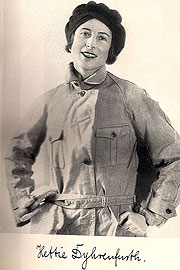
Left: Yarmila Marton, 26 in 1934, a professional actress, steals the show from Hettie Dyhrenfurth.
Right: Hettie Dyhrenfurth, aged 42 in 1934. By climbing Sia Kangri (7,422 m), she beat the altitude record held by Fanny Bullock Workman for 28 years on Pinnacle Peak (6,930 m).
In 1936, the turn came for the French. The FFME, under the leadership of Henri de Ségogne, tackled Gasherbrum I. Bad weather put an end to their efforts at Camp V (6,800 m).
Gasherbrum II: the Austrians score the first point
But the giants of the era, those who could resist (almost) nothing, came from Austria.
1953: Hermann Buhl conquered Nanga Parbat (8,126 m) in a saga we'll come back to later. In 1954, Cho Oyu was no match for Herbert Tichy.
In May 1954, the Austrians struck again. Eight of them climbed Baltoro and set up their base camp at the junction of the Abruzzo and South Gasherbrum glaciers. They ascended the latter and climbed the slopes of the south-west ridge of Gasherbrum II.
On 30 June, an avalanche swept through Camp I (6,000 m), swallowing up much of their equipment. They persevered and set up camps II (6,700 m) and III (7,150 m) along the ridge. The final bivouac was at 7,500 metres, without oxygen.
On 7 July 1956, Fritz Moravec, Josef Larch and Hans Willenpart crossed below the summit pyramid, climbed the east ridge and gained a foothold on the narrow summit of Gasherbrum II. A fine victory on a summit that presented no major difficulties.
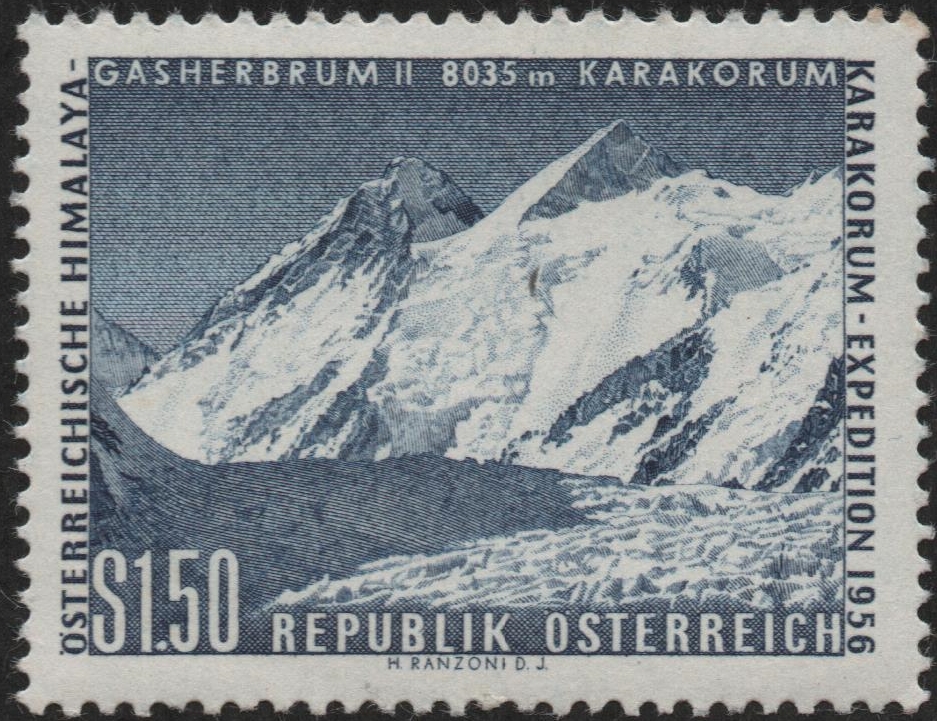
Austrian stamp (1957)
Gasherbrum I: Uncle Sam has the last word
On 6 June 1958, the American expedition led by Nick Clinch resumed the route partially covered by André Roch in 1934, along the south-west ridge of G I. On 22 June, Camp III at 6,600 meters, on the site of the highest point reached by the 1934 climbers. Camp IV at 6,850 meters. On 4 July, camp V at 7,300 meters.
On 5 July, after an exhausting four-kilometre ascent of the upper plateau in powdery snow, Andy Kauffman and Pete Schoening reached the summit using oxygen. Dyhrenfurth had suggested using skis for the summit plateau. The winners regretted not following this suggestion.
1959-1974 the military dictatorship forbade access to Baltoro
Organising an expedition to Pakistan required patience and perseverance on the part of those in charge. But on 28 October 1958, all discussions were closed. Coup d'état, martial law, military dictatorship, the Indo-Pakistan war and the war of secession (which saw the creation of Bangladesh) followed one another. For fifteen years, Baltoro returned to its ancestral isolation.
In 1971, the army relinquished power. The newly elected President Ali Bhutto drew up a new constitution, which is still in force today. In 1974, mountaineers were once again able to apply for permits. No fewer than nineteen were granted in 1975. Two of them deserve a special mention.
Gasherbrum II, second ascent, first French climb, first tragedy
Under the leadership of Jean Pierre Frésafond, the Lyon section of the CAF organised its first expedition. The cast included Yannick Seigneur, Marc Batard, Frédéric Bourbousson, Bernard Villaret and Louis Audoubert, a truculent character and seasoned Pyrenean climber. They tackled the south-east spur, a route recommended in 1934 by Dyhrenfurth: "I consider this route to be very favourable, moderately difficult, very direct, with no objective dangers".
On 18 June, Marc Batard and Yannick Seigneur, after a bivouac at 7,650 metres, reached the summit at 9am, without oxygen.
On the way down, they met Louis Audoubert and Bernard Villaret and suggested that they bivouac. Unfortunately, a storm blew in during the night, leaving Louis and Bernard stranded in their tiny tent. After a gruelling 48-hour wait, Louis set off downhill, but Bernard stubbornly waited for a lull. Exhausted and at the end of his tether, Louis was taken in above Camp II. The storm raged for eight days, and Bernard did not reappear.
Messner and Habeler: an 8,000 for two
Back in Rawalpindi, Louis Audoubert was visited by Reinhold Messner and Peter Habeler. Louis recounts his terrible misadventure. Messner and Habeler asked him for advice. What could the two of them do with their limited resources? Finally, they set off towards the Gasherbrum. They reached the snowy saddle between Gasherbrum I and II on 8 August. Bivouac. A steep but obvious couloir split the left side of the north-west face of Gasherbrum I. To go faster, they didn't rope up, didn't put down any fixed ropes and climbed all the difficulties without using belays. A new bivouac at 7,500 metres.
On 10 August, they reached the summit of Gasherbrum I. The descent, by the same route, of course without fixed ropes, required extreme concentration.
This was Reinhold Messner's third "8,000", but above all his first as an alpine technician, with a two-man team, no altitude porters, no countless shuttles between camps and no respiratory assistance.
This success prefigured the era to come of light ascents using "alpine technique". A great success for its time.
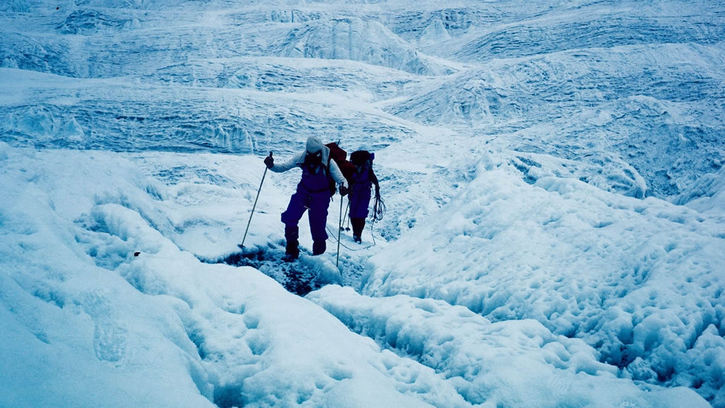
Reinhold Messner 1984
The Gasherbrum II, a superb objective for a first experiment at eight thousand meters
The great success of the Americans in 1958, confirmed by the French in 1975, showed that the Gasherbrum II does not offer any major difficulties or, compared with its close neighbours, any major objective dangers. Only avalanches, linked to possible heavy snowfalls, can pose a real danger.
Below is the animated itinerary for the ascent of Gasherbrum II, with a flyover of the extraordinary neighbouring peaks: K2, Broad Peak,...
Text and animation by Didier Mille.
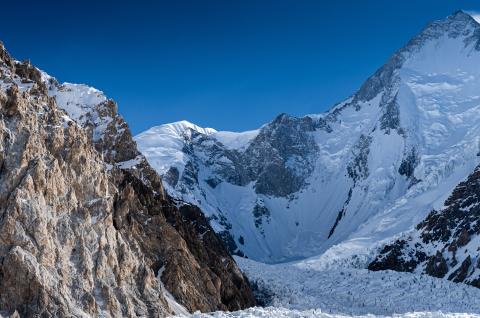
Climb Gasherbrum I at 8080 meters in Pakistan
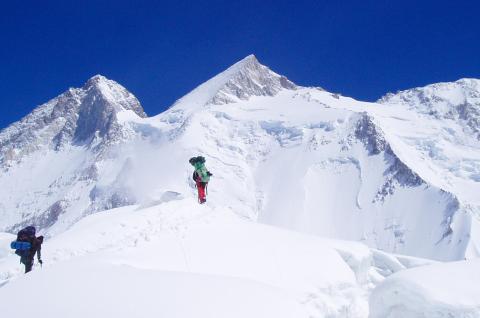

 Expeditions Unlimited blog
Expeditions Unlimited blog